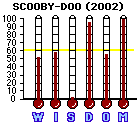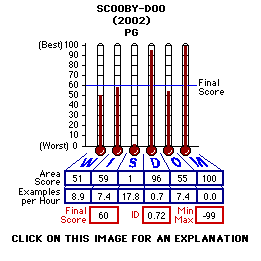Click on CAPCon Alert
image for explanation
A service to our youth through you,
their parents and grandparents, in His name by His Word
MAR22062
SCOOBY-DOO (2002), PG
Analysis Date: June 13, 2002
CAP Score: 60
CAP Influence Density: 0.72
MinMax: -99

Click on CAPCon Alert image for explanation |
A service to our youth through you, their parents and grandparents, in His name by His Word MAR22062 SCOOBY-DOO (2002), PG Analysis Date: June 13, 2002 CAP Score: 60 CAP Influence Density: 0.72 MinMax: -99 |
 |

Boxart ©Warner Bothers, Hanna-Babarbera  Scooby-Doo 2002 (PG) -- ...the "new doo" indeed. Distributed by: Warner Brothers Director(s): Raja Gosnell Producer(s): Joseph Barbera, Sheryl Benko, Robert Engelman, William Hanna, Stephen Jones, Andrew Mason, Charles Roven, Kelley Smith-Wait, Richard Suckle Written by/Screenplay: William Hanna, Joseph Barbera, Craig Titley, James Gunn Cinematography/Camera: David Eggby Music: Chris Ballew, James Gunn, David Newman Film Editing: Kent Beyda Casting: Felicia Fasano, Anne McCarthy, Tom McSweeney, Mary Vernieu Production Design: Bill Boes Art Direction: Bill Booth, Donna Brown Production still ©Warner Bothers  To our private distribution I said I was going to open the Summary/Commentary section of our analysis of Scooby-Doo with a report by Martha W. Kleder of the Culture and Family Institute I received from Barry at Adelphia (Barry Kroeker). I checked the links and references in the report but in the movie I found none of the reported claims. I may have been fooled a second time by another Internet hoax. Though I could confirm none of the claims, I suspect you will agree this is the "new doo" indeed. Though I did not find any of the ignominies allegedly reported by the Culture and Family Institute, this movie is not innocent by any means. The "original cast" Mystery, Inc. of the TV Scooby-Doo cartoon series were represented by Sarah Michelle Gellar as Daphne Blake, Linda Cardellini as Velma Dinkley, Matthew Lillard as Norville 'Shaggy' Rogers, Freddie Prinze Jr. as Fred Jones and Scott Innes as the voice of Scooby-Doo. In this episode, the crew of Mystery, Inc. are lured to Spooky Island by Emile Mondavarious (Rowan Atkinson) to find out why all the college kids at the island came normal but left like zombies. The Mystery, Inc. crew had to be lured to Spooky Island individually since they had split up two years earlier over a spat of who held what position on the totem pole ... a condition not seen in the original Scooby-Doo TV series. The MPAA rated this kids show as PG. The CAP machine gave it a score of 60 which places it in the scoring range earned by PG-13 movies. If it were not for Daphne's main outfit, the scoring would have been much higher. When a young woman repeatedly exposes the skin of her chest below her breast line and much of the skin of her breasts by wearing a very wide and low cut dress throughout a show, it is considered excessive. Other sexual matters in Scooby-Doo included Fred saying "I can look at myself naked" after his and Daphne's spirits were swapped with each other. Daphne in Fred's body telling Fred in Daphne's body to "stop touching me" while Gellar was touching herself suggestively made clear the "statement" of that programming segment. The gang had solved a mystery of a haunting of a factory by its janitor who loved the owner who could not reciprocate his love. In the news coverage of the caper closure, the gang became disillusioned with each other since everyone was trying to take most of the credit for solving the mystery -- except Shaggy ad Scooby who remained friends and life-long pals to the end. Even Scrappy-Doo appears in this brightly colored, dimly engineered attempt at movie-fying the TV series. But Scrappy is not at all likable. For bouncing around the Mysterymobile like the adolescent on too much sugar and for urinating on Daphne's chest, Scrappy is kicked out of the Mysterymobile and left on the side of the road. Indeed, Scrappy is demonic and bitter with a hugely misshapen grotesque head of monstrous proportions and features and an attitude to match. Speaking of monsters there are a few, looking more like gargoyles than monsters. One for each of the victims of demonic possession. The quintessential lord of nogoodnicking was out to soak up the inner ectoplasmic spirit - the soul - of every one who came to the island so he and his demons could have power to rule the world. Whom (or what) else do you know of has demons as servants and is after all souls on the earth? The master madman was collecting the souls in a soup and was going to inject them all into himself. But Shaggy and company got in his way. But as I said inn the first paragraph, Scooby-Doo is anything but innocent. A few of the issues that would probably make mom/dad uncomfortable include excessive cleavage and dressing to maximize the female form and/or skin exposure throughout the movie. Of particular boldness in adding sexual immorality to this feature was Prinze saying "I can look at myself naked" while Gellar was touching herself and her "spirit's host" saying "Stop touching me." Other issues of sexual programming include Gellar being touched inappropriately as she portrayed trying to escape the clutches of a would-be captor. Revealing swim wear, a crotch hit and camera angles to force the viewer on private parts topped off the sexual presences in this movie [1Cor. 6:18, Col. 3:5]. There is only one use of the three/four letter word vocabulary hidden behind a contemporary term. But of impudence on the part of the movie makers was a flatulence and burping contest between Shaggy and Scooby, one of them being ignited from within a suit of armor. Of clear toilet humor focus in the haunting of the factory segment, Daphne's head ends up under Scooby's tail. These matters and massive tattoos, Scrappy urinating on Daphne's chest and facial piercings comprised most of the point loss in Impudence/Hate [Is. 2:17]. There were a few episodes of a somewhat violent nature, most of them comic and action related. Demos attacking the gang and other action violence are probably the most invasive of the issues of violence. The portrayal of the practices of voodoo, [2Chr. 33:6] the "skull" theme of the island amusement park, demon possession and two uses of God's name in vain but both without the four letter expletive comprise the most of the point loss in Offense to God. The listing in the Findings/Scoring section will reveal all that was noted. SCRIPTURAL APPLICATION(S) If needed to focus or fortify, applicable text is underlined or bracketed [ ]. If you wish to have full context available, the Blue Letter Bible is a convenient source. If you use the Blue Letter Bible, a new window will open. Close it to return here or use "Window" in your browser's menu bar to alternate between the CAP page and the Blue Letter Bible page. *******Food for Daily Thought******* As always, it is best to refer to the Findings/Scoring section -- the heart of the CAP analysis model -- for the most complete assessment possible of this movie. |
 Wanton Violence/Crime (W): Impudence/Hate (I)(1): Sex/Homosexuality (S): Drugs/Alcohol (D): Offense to God (O)(2): Murder/Suicide (M)(3): |



 |
 |
 |
 Christian Media News |
 Biblical based Management Consulting |
 A Singles Christian Network |
 |
 |
 |
 |
| NOTE: The CAP Analysis Model makes no scoring allowances for trumped-up "messages" to excuse or for manufacturing of justification for aberrant behavior or imagery, or for camouflaging such ignominy with "redeeming" programming. Disguising sinful behavior in a theme plot does not excuse the sinful behavior of either the one who is drawing pleasure or example from the sinful display or the practitioners demonstrating the sinful behavior. This is NOT a movie review service. It is a movie analysis service to parents and grandparents to tell them the truth about movies using the Truth. |
| "There are some in the entertainment industry who maintain that 1) violent programming is harmless because no studies exist that prove a connection between violent entertainment and aggressive behavior in children, and 2) young people know that television, movies, and video games are simply fantasy. Unfortunately, they are wrong on both accounts." And "Viewing violence may lead to real life violence." I applaud these associations for fortifying 1 Cor. 15:33. Read the rest of the story. From our nearly seven years of study, I contend that other aberrant behaviors, attitudes, and expressions can be inserted in place of "violence" in that statement. Our Director - Child Psychology Support, a licensed psychologist and certified school psychologist concurs. For example, "Viewing arrogance against fair authority may lead to your kids defying you in real life." Or "Viewing sex may lead to sex in real life." Likewise and especially with impudence, hate and foul language. I further contend that any positive behavior can be inserted in place of "violence" with the same chance or likelihood of being a behavior template for the observer; of being incorporated into the behavior mechanics and/or coping skills of the observer. In choosing your entertainment, please consider carefully the "rest of the story" and our findings. |
